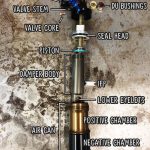The suspension fork is comprised of two key components – A spring (air or coil), which gives the fork its…well…spring, and a damper, which controls the compression characteristics and rebound. You can think of these two components as the “brains of the operation.”
Airpsring
The airspring, more common than coil springs in modern forks, is what resists the weight of the rider. The amount of force it takes to compress the fork depends on how much air you pump into the chamber. Furthermore, you can tune the airspring for a more linear or progressive feel by changing the volume of the air chamber (more on volume reduction in a future article).
- Higher pressure resists bottom-out and provides firmer compression
- Lower pressure provides better small-bump compliance and a more supple feel
Pro Setup Tip: A happy medium will resist bottom-out while still using the full travel in the gnarliest terrain for your skill level. Pay attention to your sag ring! If it’s pushed all the way to the crown after every ride, you may want to bump your pressure up a few PSI. If it’s more than about 10mm from the crown, consider dropping a few PSI.
L to R: Too much air pressure, not enough, just right.
Damper
The damper controls all motion of the fork. Without one, you’d simply have a pogo-stick, which wouldn’t lend itself very well to traction on the trail. Simply put, the damper keeps the airspring in check. Your damper is filled with hydraulic fluid and the lockout, compression, and rebound controls are actuated by opening and closing various ports through which that fluid flows. For example, when you lock out your fork, you’re simply closing all of the damper’s ports, which keeps the oil from flowing.
- More compression damping will resist the fork moving through its travel. For those familiar with FOX’s CTD switch, “Climb” = most compression damping while “Descend” = least compression damping.
- Rebound controls how fast the fork returns to full length after being compressed. No rebound damping is, in essence, a pogo-stick.
Pro Setup Tip: Rebound controls – A good starting point is to have the fork fast enough to rebound fully before absorbing your next impact, and not too fast to bounce you out of your line. This will depend 100% on how fast you like to ride and how tightly spaced the obstacles are.
Uppers
Also known as the crown-steerer unit (CSU), the uppers contain the steer tube, crown, and legs (AKA stanchions). The uppers make contact with bushings in the lowers, allowing them to slide up and down as your front wheel impacts obstacles or absorbs a landing.
- The Steer Tube is your bike’s connection to the fork. Nowadays, most steer tubes are tapered, meaning the base of the tube is wider than the top.
- The Crown connects your fork’s steer tube to its stanchions.
- The Stanchions are the pieces of tubing that actually slide into your forks lowers. The stanchions internally house the air spring (or coil) as well as the damper.
Lowers
The lowers connect the fork to your wheel and move upwards during compression. Lowers also house the bushings and lubricating oil, which make contact with your uppers.
- The Wiper Seals keep dirt, dust, and grime out of the internals of your fork. Keeping these clean and lubricating them often is essential to a plush feeling fork. Your wiper seals, like brake pads, are routinely replaced as they wear out.
- The Foam Rings hold lubricating oil close to seals and bushing for optimal lubrication



